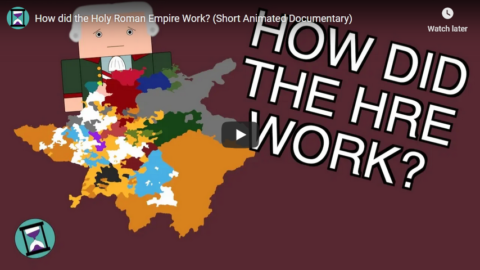SandRhoman History
Published 7 Feb 2021Everybody quarrels over the efficacy of the English longbow. Many historians, reenactors and history enthusiasts alike hold the view that arrows piercing armor is a myth. Some base this view on testing as was done for example by Tod from Tod’s workshop. Together with his team, he provided an invaluable data point for this debate. Others, such as traditionalist historians are often open to the possibility of arrows piercing armor, even though they are aware of actual testing of the longbow. In general, the efficacy of a weapon is much more complicated than its mere armor penetration value. So, in this video we’d like to shed light on the whole debate and explain why it is so hard to find common ground on this issue. This is why everybody disagrees on the efficacy of the English longbow.
Patreon: https://www.patreon.com/sandrhomanhis…
Twitter: https://twitter.com/Sandrhoman
Tod’s Video: ARROWS vs ARMOUR – Medieval Myth Busting https://youtu.be/DBxdTkddHaE
Tod’s playlist: MEDIEVAL MYTH BUSTING https://youtube.com/playlist?list=PLI…
Bibliography:
Rogers, C.J., The Efficacy of the English Longbow, 1998.
Devries, K., Medieval Military Technology, 1994.
Bane, M., “English Longbow Testing against various armor circa 1400”, 2006.
Soar, H., Gibbs, J., Jury, C., Stretton, M., Secrets of the English War Bow. Westholme, 2010, pp. 127–151.
Magier, Mariusz; Nowak, Adrian; et al., “Numerical Analysis of English Bows used in Battle of Crécy”. Problemy Techniki Uzbrojenia. 142 (2), 2017, 69–85.
February 8, 2021
Why Everybody Disagrees on the Efficacy of the English Longbow – A Video Essay
The quality of medical information available to journalists
Scott Alexander shows the conflicting agendas of journalists and the medical professionals they depend on for their background information in writing about medical issues:
I heard from a journalist yesterday after writing yesterday’s post on WebMD. They’ve been trying to write a coronavirus article worthy of Zvi or any of the other illegibly smart people writing on the pandemic. Apparently the bottleneck is sources.
In most journalistic settings, you can’t just write “here’s what I think”. You have to write “here’s what my source, a recognized expert, said when I interviewed them”. And the experts are pretty sparing with their interviews for contrarian stories.
The way my correspondent described it: sources don’t usually get to approve the way they’re quoted in an article, or to see it before it gets published. So they’re really cagey about saying anything that might get misinterpreted. Maybe their real opinion is that X is a hard question, there are good points on both sides, but overall they think it probably isn’t true. But if a reporter wants to write “X Is Dumb And All Epidemiologists Are Idiots For Believing It”, they can slice and dice your interview until your cautiously-skeptical-of-X statement sounds like you’re backing them up. So experts end up paranoid about saying potentially-controversial-sounding things to reporters. And since reporters can’t write without sources, it’s hard for them to write anything controversial about epidemiology.
The incentives for the journalist and their editor is to find a sensational angle to get as many people to read the piece as possible (“clickbait” works). The incentives for the “expert sources” are to avoid saying anything substantive that might provide such an angle (“don’t become a headline”). It’s no wonder that journalists with no specialized training in the experts’ area are unable to produce fully informative articles for public consumption.
How did the Holy Roman Empire Work?
History Matters
Published 25 Aug 2019Twitter: https://twitter.com/Tenminhistory
Patreon: https://www.patreon.com/user?u=4973164
Merch: teespring.com/stores/history-matters-…Special Thanks to the following Patrons for their support on Patreon:
Kevin Sanders
Chris Fatta
Daniel Lambert
Richard Wolfe
Joshua
Tom Loghrin
Warren Rudkin
Andrew Niedbala
Mitchell Wildoer
Blaine Tillack
Bernardo Santos
Matthew
John Garcia
Richard Hartzell
Will Davis-Coleman
Danny Anstess
Henry Rabung
August Block
Perry Gagne
Shaun Pullin
Joooooshhhhh
Vesko Dinev
PaulToon
Kelly Moneymaker
FuzzytheFair
Armani_Banani
Jeffrey Schneider
Byzans_Scotorius
Seth Reeves
Haydn Noble
Josh Cornelius
Gideon Rashkes
Spencer Smith
Cornel Borină
Roberto
Andrew Keeling
Richard Manklow
Chance Cansler
João Santos
Gabriel Lunde
Pierre Le Mouel
anonHow did the Holy Roman Empire work? It was an antiquated mess but it did have a system of government that did work. Sort of. If everyone felt like it.
Sources:
Prussia’s Relations with the Holy Roman Empire, 1740-1786 by Peter H. Wilson.
Benjamin Franklin, Student of the Holy Roman Empire: His Summer Journey to Germany in 1766 and His Interest in the Empire’s Federal Constitution by Jürgen Overhoff.
The Constitution of the Holy Roman Empire after 1648: Samuel Pufendorf’s Assessment in His Monzambano by Peter Schröder.
Bolstering the Prestige of the Habsburgs: The End of the Holy Roman Empire in 1806 by Peter H. Wilson.
QotD: The deeply rooted anti-Americanism in Canadian politics
… in 2011, the only time Conservatives have managed to win a federal majority in the last three plus decades, they ran one of the most effective campaigns in recent memory against Michael “just visiting” Ignatieff by waging a patriotic campaign against him. In Ignatieff the Conservatives had the perfect rival to attack; a patrician member of the Laurentian new class. But the campaign against Ignatieff wasn’t just effective because it successfully portrayed him as an elite, it was effective because in attacking the time Ignatieff had spent aboard and at Harvard especially, they actually managed to make the Conservatives the champions of Canada, and the Liberals the more American party.
Ben Woodfinden, “True North Patriotism and a Distinctly Canadian Conservatism”, The Dominion, 2020-10-20.






